What do you know about bioeconomy?
Bioeconomy is a wide concept and it can be defined in many ways. The European Commission defined it in 2012 as the production of renewable biological resources and the conversion of these resources and waste streams into value added products, such as food, feed, bio-based products and bioenergy. In other words, renewable natural resources are used in a sustainable way to produce food, energy, products and services in the bioeconomy.
The bioeconomy can increase the availability of biomass by
- using more biomass components such as sugars, fibers and fats from plants, and by implementing more efficient refinery techniques.
- growing more biomass crops mostly on underutilized land.
- developing better biomass varieties and improving agricultural production techniques. (BLOOM Key Messages)
In the bioeconomy, sugars and wood can be compared to crude oil in the fossil-based economy, in the sense that they can be used to create a wide range of products as it is noted in one of the Horizon 2020 project BLOOM Key Messages.
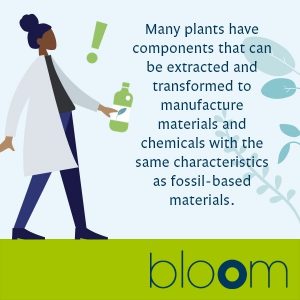
What are the bio-based products?
Bioproducts or bio-based products are products that are made from biomass and usually they are developed to replace products made of oil-based plastics or other non-renewable materials. Sometimes it is not possible to produce a whole product from bio-based material, so material can be composite with bio-based material and some other material. However, the major of the material is bio-based. Common material of bio-based products in Finland is wood, but there are plenty of other origins of materials, such as sugarbeet, starch and even bacteria. Generally, bio-based products and materials are recyclable and/or biodegradable. By using them instead of the oil-based or mineral based materials, it is possible to reduce the use of fossil resources, carbon footprint and wastes.
These days there are many kind of new and innovative bio-based products available in the market. And they are coming more! Here are some examples of wood-based bioproducts:
Woodly-based plastic is transparent and behaves like plastic, but it is far from traditional oil-based plastic. Woodly plastic packaging is made from cellulose polymer, which comes from wood. The cellulose is modified with different building blocks to make it behave like plastic. Woodly is a carbon neutral material and it can be recycled in the plastic recycling stream. It is used as wrapping material for salads and flowers.
https://woodly.com/plastic-from-wood/
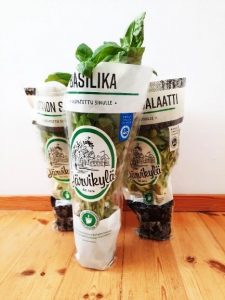
Paptic is packaging material which combines the qualities of paper and plastic. It is produced out of wood-based fibre that contains more than 70 % wood. The material is formed with foam forming technology that saves the raw material and improves the qualities of the material. The material is spatter-proof but is decomposed when put under water. It is more durable than paper, it maintains its shape better than plastic. The material is recycled with cardboards.
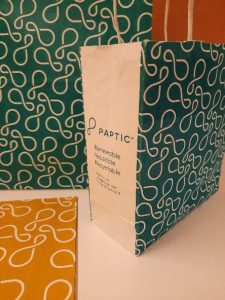
Jospak®-tray solutions are developed to decrease the challenge of packaging waste in food industry. The tray is formed from renewable and recyclable corrugated board and it helps to reduce the amount of plastics up to 85%. It is material efficient and distinctive as the brand and product information can be printed directly to the tray. (The New Wood Project)
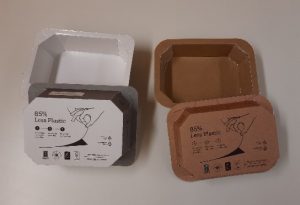
UPM Formi biocomposite granulates are produced out of pulp fibers and plastic. The amount of renewable fiber in the final product is 20-50 %. The material can perfectly be applied into production of different industrial and consumer products, for example in furniture and car parts, loud speakers, small electronical devices. It can be used in injection moulding and 3D printing. The material can replace non-renewable oil-based raw materials with bio-based ones. The amount of renewable fiber in the final product is between 20 and 50 percent. The material is recyclable and fits into existing recycling streams. It is also suitable for energy production after disposal.
https://www.upmformi.com/biocomposite-products/
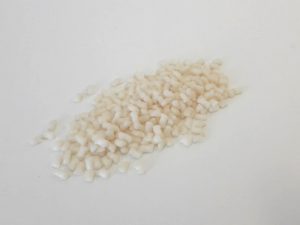
Sulapac tins are made from wood chips and biodegradable natural binder and they have features similar to plastic. These packaging products tolerate water and fats and they do not let through oxygen. Sulapac products combine ecology, luxury and limitless designing. Sulapac can compete with traditional plastic tins in costs and is suitable for same packing devices as plastic tins.
https://www.sulapac.com/portfolio/
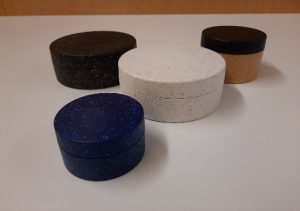
Woodio produces wood composite sinks and other bathroom furniture. The composite is produced by molding a mixture of wood chips and crystal-clear binder that the company has developed. Woodio has developed a solid wood composite that is entirely waterproof. The material is beautiful and easy to work with and it has many similar features as ceramics has. Wood composite is an ecological option which can be used as energy after use (unlike ceramic waste). Solid wood composite is hard and it can be molded with wooden tools.
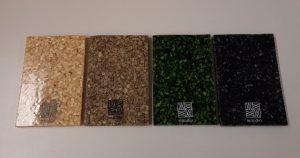
Woodcast is renewable and biodegradable casting material. It is produced out of woodchips and biodegradable plastic. The casting material is hard and durable in room temperature but when heated, it gets flexible and self-sticky. Woodcast can be applied to all plastering and production of supporting elements. The material is breathable and X-ray transparent. It is actually used in plastering and in occupational therapy. It can be molded to any anatomical shape. Any excess pieces can be reused: used casts can be disposed of either as energy or biowaste.
The composite differs from traditional lime cast so that it doesn’t need water and it is non-toxic. Therefore, one doesn’t need gas-masks, gauntlets or suction fans when handling the cast. Woodcast is biodegradable so it can be disposed of as biowaste or energy waste.
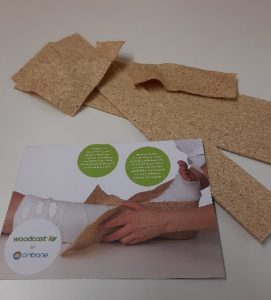
Spinnova creates textile fibre out of cellulose without involving any harmful chemicals, minimal water use and emissions and zero waste. Fibres are produced in the pulping process when the fibres are mechanically refined into a fine, paste-like material called micro fibrillated cellulose (MFC). The process suits for large variety of raw materials, e.g. certified wood or cellulosic waste streams. The process is not using dissolves or other harmful chemicals and it uses about 99 % less water than cotton production. The material is firm and warm as lamb wool. The Spinnova fibre is completely natural. Spinnova´s raw material commitment is to use only FSC and/or PEFC certified wood or cellulosic waste streams. The fibre can be recycled without chemicals and it is biodegradable in natural and marine environments in some months.
Repolar Pharmaceuticals produces a large variety of resin based medical products for human care as well as for animals. Resin based products are used for example in wound care, fungal infections, irritated and itchy scalp, acne and ear wash for animals.
https://www.repolar.com/categories/skin-care
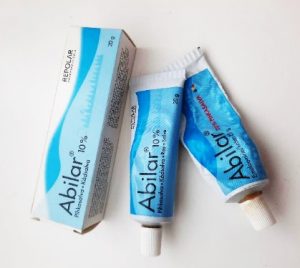
Other exciting and innovative wood-based solutions can be found in the website of The New Wood Project (Uusi puu – The New Wood project) that shows you what the tree can do!
This blog is based on the experiences and knowledge gained during the past three years under European BLOOM project funded by Horizon 2020 Programme. More information about bioeconomy and bioeconomy communication between different entities is available in BLOOM website:
For example, you can try out your knowledge of bioeconomy by playing quiz (http://quiz.bloom-bioeconomy.eu/), packing your bioeconomy suitcase (https://www.youtube.com/watch?v=2fOGs3f-P0I) or exploring BLOOM videos (https://bloom-bioeconomy.eu/videos/) about bioplastics, innovative textiles and many other interesting topics related to bioeconomy!
Kirsi Knuuttila, Project Manager & Tuija Manarus, Project Specialist, JAMK University of Applied Sciences, Institute of Bioeconomy